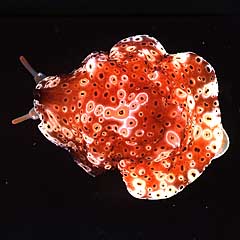|
< Previous family introduction |
|
|||||
 |
Family Velutinidae Velutinids
|
|||||
|
The Velutinidae is a family of molluscs with completely, or nearly completely, internal shells. . The shells are fragile, usually white, with a depressed spire and a wide opening like an abalone. The closest relatives of the Velutinidae are the Triviidae, which have cowry-like shells and a retractable mantle; even though the shells are quite different the basic structure of the animals is very similar.. In external appearance velutinid animals are usually brightly coloured with a rugose mantle exterior and a coloured foot. There are sensory tentacles with eyes near their bases and a short but prominent siphon. In NSW they are uncommonly found in the intertidal, secreted under stones. They have been photographed down to 20 m, and extend into deeper water, but the depth to which they extend is unknown. The animals feed on compound ascidians, and are camouflaged by being a similar colour to their prey. The biology and taxonomy of the Atlantic species and of one species from the of Indo-West Pacific has well studied, but the Australian members of the family are poorly known. One tropical Indo-West Pacific species, Coriocella nigra, is known from northern NSW. Some South Australian species were described and very well illustrated by Basedow (1905), but he did not place his species within any geographic distribution. Allan (1936) reported on a specimen from off Cape Everard, northern Victoria, and decided it was of the same species as one Basedow had described. Iredale (1936) named a species from a shell from Sydney Harbour dredgings, and hence possibly fossil, but did not associate it with an animal. Allan (1958) investigated and illustrated in detail four species from NSW, but did not attempt to name them. Hence the species which occur in Australia, and their distribution, is largely unknown. Seven species from NSW are illustrated here by images of live animals from the Australian Museum Malacology photo collections. The situation remains of not knowing the names and distributions of these animals. Family Reference: There is no consolidated reference to the family in Australia. Coverage The only two species for which shells are positively identified are detailed here.
|